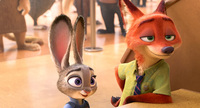Wednesday, March 2, 2016
Disney's Zootopia A Triumph In Computer Animation, As Much As Filmmaking

Most moviegoers, when they go to the movies, aren't thinking about the technical aspects of a movie--only if that they are drawn into a world and enjoy the story. However, Disney's Zootopia--which opens in the U.S. tomorrow, March 3rd--marks a huge technical milestone in the art of moviemaking, which demonstrates much the world of making movies has become nearly as sophisticated, technically--and maybe, even more so--than the latest product release from the most advanced cloud startup. Zootopia centers on the interaction between an up-and-coming police officer, Officer Judy Hopps, and a scam artist, fox Nick Wilde, and their efforts to solve the mysterious disappearance of animals in the city of Zootopia.
The technical work that went into Disney's Zootopia far exceeds the efforts behind many a local startup. Zootopia's technical staff--located here in Southern California--included more than 120 software engineers, IT, and other technology professionals, who build a huge body of very advanced, modeling and simulation software, which drove the animation that eventually made it to the big screen.
According to the producers and staff behind Disney's Zootopia, in a rare technical look and preview of the film recently held at Disney's Glendale animation studios, the modeling and simulation of fur movement in Zootopia includes more than 64 different species of animal, a nearly logarithmic increase from the modeling for a film like Disney's Bolt, the last computer animated film with a furry main character. According to the producers Byron Howard and Rich Moore, who presented at the session, not only did Zootopia's team have to tackle modeling hair and fur--considered one of the biggest challenges in computer animation--but modeled wind, fog, rain, and the atmosphere, plus water, vegetation and trees. The amount of detail poured into those models went down to individual hairs of all of the animal species in the film, down to the follicle level, and even modeling the musclature and skeletal structure of each animal.
The Disney team had to create software that simulated wind and atmosphere across six different environments -- different parts of the fictional Zootopia, a giant leap from Bolt, the last computer animated animal film from Disney which essentially only had one, urban environment. That effort, although subtle, is omnipresent throughout the film where the wind through the trees is as realistic as real life, with wind blowing through the fur of the characters and also in the background, with individual leaves and branches acting as they might in the real world.
According to Disney VFX Supervisor Scott Kersavage, Zootopia consumed 424 terabytes of disk space, compared with 322 TB consumed with Big Hero 6, and they consumed over 1 million render hours per day at the peak of production. It took a total of 218 million render hours on the show, compared with 200 million on Big Hero 6 -- an example of why Southern California's entertainment industry has been key consumer of technology (and storage), which drives those massive rendering resources.